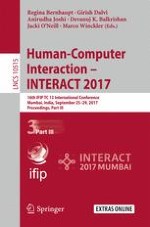2017 | OriginalPaper | Buchkapitel
Pupil-Assisted Target Selection (PATS)
verfasst von : Christoph Strauch, Jan Ehlers, Anke Huckauf
Erschienen in: Human-Computer Interaction – INTERACT 2017
Aktivieren Sie unsere intelligente Suche, um passende Fachinhalte oder Patente zu finden.
Wählen Sie Textabschnitte aus um mit Künstlicher Intelligenz passenden Patente zu finden. powered by
Markieren Sie Textabschnitte, um KI-gestützt weitere passende Inhalte zu finden. powered by
